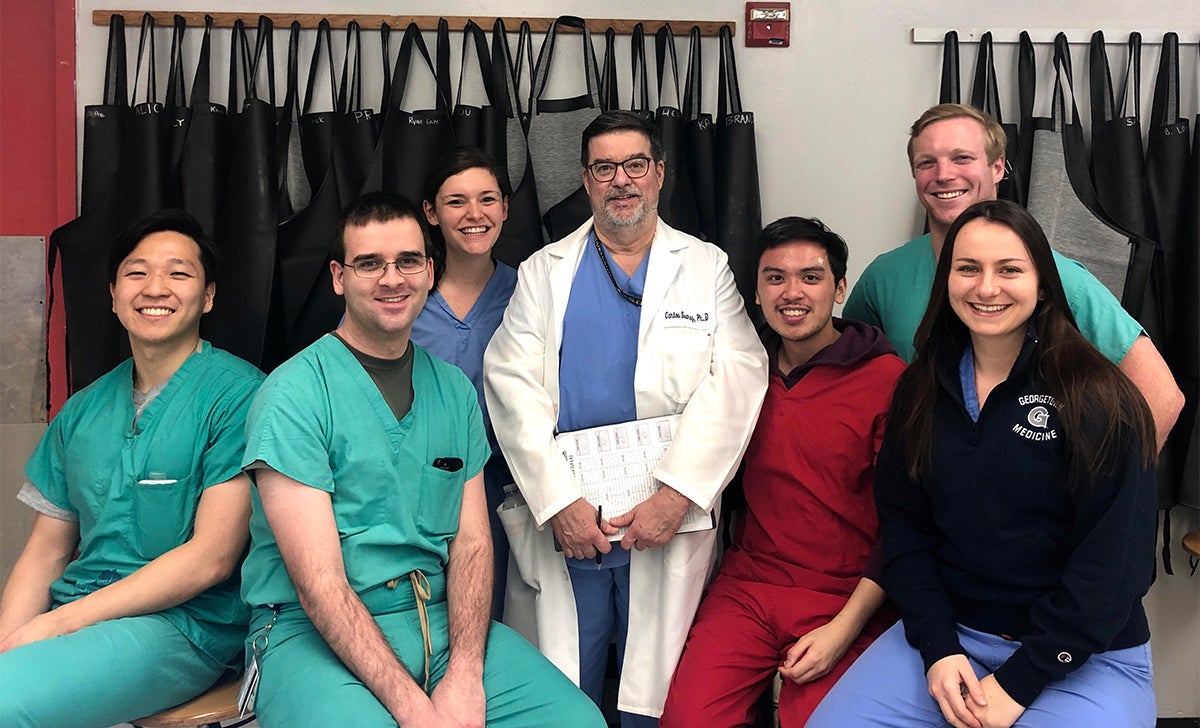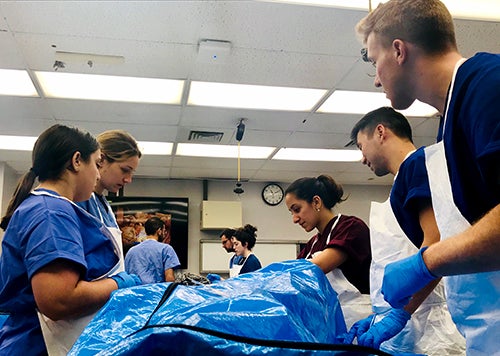Students Find Support and Mentorship Through Anatomy Program

Posted in GUMC Stories | Tagged medical education, School of Medicine, service to others
(February 1, 2019) — Despite attending lectures and memorizing diagrams of the human body, the sights, sounds and smells of gross anatomy lab can stir up unexpected emotions in first-year medical students. Therefore, a group of students with anatomy lab experience volunteer to support the first-year medical students at Georgetown University School of Medicine (GUSOM) taking gross anatomy.
As a fourth-year medical student taking an elective in clinical gross anatomy, Monika Gasiorek (M’19) recalled being hesitant in anatomy lab during her first year, not unlike many first-year students she assists, and emphasized that her confidence came with experience and time.
“I knew I wanted to do this since first year when I saw fourth-year students in lab,” she said. “It’s a way to help students practice technical skills and learn anatomy, not from a book or a picture, but in a hands-on, low stakes way.”
A Positive Experience for First-Years
After being divided into small groups, the first-year students are assigned a deceased human body, or cadaver, to work with throughout the duration of gross anatomy lab, which spans into their second year. These groups dissect the same body together, take quizzes as a team and learn from each other.

Trading in their textbooks for scrubs, the class of 2022 began gross anatomy on January 11, marking the first time that they worked with cadavers as part of their medical education. First-year students have found the support from their more experienced peers invaluable, especially when there are several groups dissecting in a room at the same time.
“It’s great to have them there because they’ll get involved, help us with a dissection,” said Kevin McGowan (M’22). “It’s not an easy thing to do. We’ve never dissected on this scale before, so it’s useful to have [other students] there who have already done it and enjoy doing it.”
Caroline King (M’22) began the gross anatomy course as a student in Georgetown’s Special Master’s Program, a one-year program tailored to college graduates applying to U.S. medical schools, and completed the full course over the summer to serve as a teaching assistant in her first year. She was excited to help her classmates by sharing her knowledge.
“I’ve been pleasantly surprised at how easy it is to help out my peers,” King said. “There’s no difference between us except for the fact that I took the course before them. The first day was pretty overwhelming because I wasn’t anticipating how many people were going to need my help.”
Mentorship Opportunities During Dissection
Indirectly, the program has also fostered mentorship among students. Working in the lab for hours at a time has allowed for students to connect with their peers and ask questions on topics other than anatomy.

“If they’re not struggling with a dissection, they’ll ask me about [my specialty], where I’m applying, what the process is like,” Gasiorek said. “Sometimes they ask questions about anatomy and physiology outside of what they’re doing. And, sometimes, they just ask about medical school.”
Supporting first-year students in the anatomy lab is a way of giving back to a future generation of physicians, Arthur Jurao (M’19) said, reflecting on his own experiences.
“They make the same mistakes I did,” Jurao said. “This is my opportunity to make sure they don’t continue to make those mistakes. They’ll be my colleagues in a few years, and if I can help them learn their anatomy, that’s really important.”
The Ultimate Gift for Medical Students
The ability to learn from the human body is not something that Georgetown students take lightly. In fact, as part of GUSOM’s Anatomical Donor Program, first-year students are given the opportunity to write an obituary for the deceased person whose body they will later dissect.
Milos Tomovic (M’22) was one of the first-year students who volunteered to write an obituary and connected with the donor’s family prior to his first day in the lab.
“I think it’s a disservice not to write an obituary,” Tomovic said. “It brings life to the body on the table and adds a little more purpose to every incision, every cut we make.”
“Before we opened the bag, I was able to look around at my team and tell them about the body before us. He was a man from Michigan who loved ice cream as much as he loved his books.”
The students also spoke to the unique qualities of Georgetown’s Anatomical Donor Program, and how special it was to know that the donors chose to give their bodies to science.
“It’s almost a sacred bond you have with these donors, because they wanted us to learn from them,” McGowan said. “We think we’re learning on a body, but, actually, that person dedicated their body to teach us.”
King echoed this sentiment by emphasizing the powerful choice made by donors and what it means for students.
“The last wish they had was to give the gift of knowledge to medical students,” she said. “This person is your greatest teacher in medical school. It’s the most incredible gift that medical students can receive.”
Giuliana Cortese
GUMC Communications
